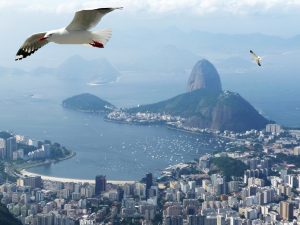With the Olympics in full flow, Rio De Janerio, as the host city, has featured widely in the news. Honestly, we love Rio – it’s vibrant with dazzling landscapes, a very active cultural scene and some great beaches. To get you acquainted to this Cidade Maravilhosa (Marvellous city) as it is nicknamed, we’ve created a cheat sheet – featuring all you need to know about Rio.
Facing the South Atlantic coast, the second-largest city in Brazil (after Sao Paulo) with a population of 6.3 million, is blessed with one of the most beautiful natural settings for a metropolis in the world. Here are some things you might see during the Olympics coverage:
Christ The Redeemer: This is the most iconic imagery of the city and the one that you will see most regularly in any coverage of the city. Perched atop the 710 meter (2,330 feet) high peak of Corcovado Peak, the statue of “Cristo Redentor” stands with arms outstretched, gazing serenely out over the city. Standing 38 m tall, this is the largest Art Deco statue in the world and the fifth largest Jesus statue.
Fun fact: Owing to it’s location, it is frequently struck by lightning and has lost/ damaged a thumb, an eyebrow and a finger because of it recently.
Copacabana beach: Rio’s most iconic beach is where the city gathers during weekends. Rio locals, called “cariocas,” always seem to have a game of soccer or volleyball in play, and vendors vociferously hawk their drinks and snacks from the kiosks that line the beach along the 4 km promenade that borders the beach. The walkway features a wave-like design laid out in black and white stones. Inland from the promenade are closely-packed hotels and apartments.
Fun fact: Rod Stewart played to an estimated 3.5 million people on Copacabana beach in 1994, the largest concert ever held in the world
The Rio Carnival: The biggest and brashest carnival in the world, the Rio Carnival sees up to two million people on the streets daily and dates back to 1783. At the heart of the carnival lies the true spirit of the city – music and dance, samba in particular.
Fun Fact: During the Carnival, the mayor hands over the keys of the city to a man called King Momo, whose appearance signifies the beginning of the festivities. Selected every year, this legendary ‘party animal’ then takes the helm throughout the jamboree, but he slopes off at the end, presumably to nurse his hangover
Caipirinha cocktail: For a country that has the biggest street carnival in the world, it would be no surprise that they have a national cocktail! A caipiniha is made with cachaça, sugar and lime. Cachaça, also known as Pinga or Caninha, is Brazil’s most common distilled alcoholic beverage. Cachaca is a Brazilian rum made from fermented raw sugarcane juice. Its flavour is more earthy than the Caribbean rums most of us are used to, as these are distilled from molasses.
Fun fact: well, here’s a great recipe for you to try, with and without the cachaça
Ipanema beach: A long, arcing expanse of soft white sand and rolling waves, Ipanema routinely reaches the top of the “Best Beaches in the World” lists year after year. The beach is bordered by a well-organized grid of shops, cafés and restaurants as well as an array of art galleries, theatres and clubs. Located in the upscale South Zone, or “Zona Sul”, Ipanema lies between the beaches of Copacabana and Leblon.
Fun Fact: Garota de Ipanema” (“The Girl from Ipanema”) is a famous Brazilian bossa nova jazz song inspired by a girl who lived around this beach.
Tijuca National Park: One of the largest urban forest in the world, the Tijuca National Park covers a huge area of a mostly mountainous landscape. Visitors can hike to Rio’s highest peak, the Pico da Tijuca, to enjoy expansive views of Guanabara Bay and the city below. Nearly destroyed in the early 1800s by encroaching coffee plantations, much of the forest was replanted by hand in the latter half of the century, as many as nine million trees.
Fun fact: It is claimed to be the world’s largest urban forest, covering some 32 km² and is among the three urban forests of this size in the world along with the ones in Johannesburg, South Africa and Singapore.

View of Rio and Sugarloaf Mountain
Sugarloaf Mountain: Rising 400 meters (1,300 feet) above the mouth of Guanabara Bay, Sugarloaf mountain is a monolith of quartz and granite. There are cable cars that go up every 20 minutes, which gives you a great vantage point to gaze upon the city from a height.
Fun fact: Sugar Loaf Mountain is one of the largest and most popular urban rock climbing destinations in the world with over 270 different routes to explore it.
Maracana Stadium: An iconic venue that you will see more often than the others – the Maracanã Stadium is one of Rio’s most important landmarks because of their dedication to football. Once the world’s highest capacity football venue, it was able to hold nearly 200,000 people when it opened in 1950. In modern times, the capacity has been reduced because of safety considerations, and the introduction of seating for all fans. It was partially rebuilt in preparation for the 2014 World Cup and is currently able to seat 80,000 spectators making it the largest stadium in South America.
Fun fact; The 1950 World Cup Final, between Uruguay and Brazil, remains the highest attended match ever with 173,850 spectators crammed into Rio’s Maracanã Stadium, though unofficially there were said to be many more. Tragically, however: Brazil lost 2-1
While there is a lot more to Rio than these iconic elements, they do define this thriving city atleast from the outsider’s perspective and hopefully a better understanding of them will help you feel the city’s amazing vibe a little better while you watch the Olympics unfold.


